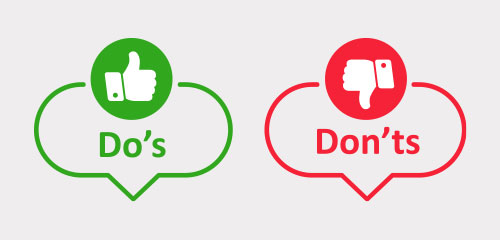Do’s and Don’ts of Crafting a Winning Proposal

In the business world, crafting a winning proposal is crucial for success. Whether seeking new clients, funding a project, or aiming to win a contract, a well-crafted proposal can make all the difference. However, it’s not just about putting words on paper; it’s about creating a persuasive and compelling proposal that impresses and convinces the reader of your organization’s value.
Crafting a winning proposal requires careful consideration and a customer-centric approach since clients often make important buying decisions primarily based on the strength of the proposal. The client will need comprehensive and convincing information to feel confident in awarding a contract to your organization. Key factors that will assure them include the proponent’s in-depth understanding of their organization’s needs, relevant experience, and a unique value proposition. The client will also look for a qualified team with evidence of past success.
To increase your chances of winning the contract and instill confidence in the client, you must provide a detailed project plan with a clear timeline, transparent pricing, and a well-thought-out risk mitigation strategy. Effective communication channels and regular reporting on project progress are essential to keep the client informed and reassured. The client seeks assurance of ongoing support, compliance with legal requirements, financial stability, and the flexibility to customize the solution to their specific needs.
Thorough research into their goals and challenges will help you create a compelling and relevant document that speaks directly to your client’s concerns. In addition to understanding your client, proposing a solution that solves the customer’s problems is essential. Highlight your proposal’s benefits, demonstrate measurable results, and offer ongoing support to showcase your commitment to your client’s success. By incorporating these elements and maintaining a customer-centric approach throughout your proposal, you position your organization for success. This comprehensive and tailored approach will make your proposal stand out from the competition and secure the trust of your clients, paving the way for partnerships and future business growth.
Let’s explore the do’s and don’ts of crafting a winning proposal to increase your chances of securing more contracts or funding. Crafting a winning proposal requires careful consideration and a customer-centric approach.
Proposal Writing Dos
- Understand Your Client: Conducting thorough research to deeply understand your client’s needs, pain points, and preferences is fundamental to crafting a winning proposal. Delve into their industry and current challenges. By tailoring your proposal to address their specific requirements effectively, you demonstrate your commitment to meeting their unique needs, fostering a sense of trust and confidence in your organization’s ability to deliver results.
- Solve the Customer’s Problems: A successful proposal proposes a solution that addresses the client’s specific challenges and goals. Your proposal should clearly outline how your innovative approach will overcome their pain points and unlock growth opportunities. Emphasize the benefits of your solution, such as increased efficiency, cost savings, or enhanced performance. Providing real-world examples and case studies illustrating how your answers have successfully resolved similar problems for other clients strengthens the credibility of your proposal.
- Present a Unique Value Proposition: Standing out from the crowd is essential in a competitive business landscape. Showcase what makes your proposal distinctive and sets your organization apart from competitors. Highlight any proprietary technologies, specialized methodologies, or exclusive partnerships contributing to your competitive advantage. Leveraging past successes and lessons learned demonstrates your organization’s track record and ability to deliver exceptional value.
- Provide Evidence and Data: To make your proposal more convincing, back up your claims with evidence, data, and real examples of successful outcomes. Use compelling statistics and results from previous projects to show your organization’s achievements. Include case studies and testimonials from satisfied clients to highlight the effectiveness of your solutions. Providing concrete evidence gives clients confidence in your abilities and builds trust in your proposal.
- Tailor Your Approach: Cookie-cutter proposals are easily recognizable by clients! Avoid the one-size-fits-all approach. Customize your proposal for each client or project to demonstrate your commitment to understanding their unique challenges and goals. Personalize the language and content to resonate with the client’s culture and objectives. Avoiding generic templates and boilerplate language showcases your dedication and investment in creating a proposal that directly addresses the client’s needs.
- Highlight Your Competitive Advantage: Clearly articulate what makes your organization stand out in the marketplace. Whether it’s your expertise in a specialized area, innovative technology, or an unwavering commitment to exceptional customer service, emphasize these strengths throughout the proposal. Showcase how your unique capabilities benefit the client and contribute to their success.
- Have a Strong Executive Summary: The executive summary is an opportunity to make a lasting impact and compel the reader to explore further. Your opening must be captivating, concise, and engaging to achieve this. Summarize your proposal’s key points, emphasizing the most compelling aspects of your solution and its potential impact on the client’s business. Demonstrate that you understand their needs and objectives, and show how your proposal is tailored to address their specific challenges.
- Use a Clear Structure: Organize your proposal in a logical sequence and easy-to-follow structure for the reader or evaluator to follow your ideas and solution. Utilize headings, subheadings, and bullet points to break down information and present it in a digestible manner. A clear structure enhances readability and comprehension, allowing the client to navigate the proposal seamlessly.
- Use Visuals and Graphics: Incorporating strategic visuals, charts, and graphics can enhance your proposal’s visual appeal and clarity. You can quickly grab their attention with well-designed visuals and easily convey complex information. Graphical representations of data, project timelines, and process flow help the client grasp critical details at a glance. A carefully chosen infographic or eye-catching chart can make your proposal more memorable and impactful.
- Be Realistic with Deliverables: Ensure your proposed deliverables are practical and achievable within the proposed timeline and budget. Avoid overpromising, as failing to deliver on commitments can damage your organization’s reputation. Present a detailed plan outlining the steps, resources, and milestones necessary to succeed, providing the client with confidence in your organization’s ability to execute the project.
- Embrace Submission Guidelines: Like a compass guiding you through uncharted waters, submission guidelines pave the path to success. Embrace and use them to ace the proposal. Pay attention to formatting guidelines, page limits, and any specific content requested. Demonstrating your ability to follow instructions and attention to detail reflects professionalism and respect for the client’s processes, strengthening your proposal’s overall credibility.
Proposal Writing Don’ts
- Underestimate Competitors: Underestimating or undermining your competitors can be a risky move. Clients are savvy and will likely evaluate multiple proposals before making a decision. Discrediting your competitors may make you appear insecure or unprofessional. Instead, emphasize showcasing your unique value proposition and what sets you apart. Emphasize your organization’s strengths, achievements, and track record of successful projects.
- Neglect Proofreading: Submitting a proposal with grammatical errors and typos sends a message of carelessness and lack of attention to detail. Such mistakes can overshadow the strengths of your proposal and create doubts in the client’s mind about your overall professionalism. Proofreading is crucial to catch and correct any errors before submitting your proposal. Take the time to review your document carefully, paying attention to grammar, spelling, punctuation, and formatting.
- Overcomplicate Proposals: When crafting a proposal, it’s essential to balance providing necessary information and overwhelming the client. Avoid the temptation to overcomplicate your proposal with technical jargon or convoluted language. Clients appreciate clarity and simplicity, so keep your message straightforward and easy to understand.
- Boast About Your Organization: While showcasing your strengths and unique selling points is crucial, excessive self-praise can backfire. Clients want to see tangible value and how your organization can meet their needs. Instead of boasting, provide evidence of your achievements, successful projects, and client testimonials demonstrating your capabilities.
- Leave Room for Doubt: Clients want to be confident in choosing a proponent, and any uncertainty in your proposal may raise red flags. Avoid using vague language or making ambiguous statements that could be open to interpretation. Clearly articulate your ideas and solutions, ensuring that your proposal is easy to understand and leaves no room for confusion.
- Little Effort: Taking a proposal lightly can be a critical mistake that undermines your chances of winning. Proposals are valuable opportunities to showcase your organization’s capabilities and secure lucrative contracts. Treating them with anything less than wholehearted dedication can lead to missed opportunities and a negative impression on the client. By treating each proposal with the seriousness it deserves, you position your organization for success and increase the likelihood of winning valuable contracts and projects.
- Postponing Writing: Postponing a proposal is a temptation many organizations face, especially when dealing with other pressing tasks. Crafting a compelling proposal involves gathering input from various subject matter experts and integrating their insights seamlessly. Postponing the writing process may also result in missed opportunities to engage with the client, seek clarification, or address any concerns they may have. Allow time for collaborative efforts and ensure the proposal comes together cohesively. Allocate sufficient collaboration, research, and strategy development time to create a well-crafted proposal.
- Disregard Compliance: Clients often provide detailed instructions on how they want proposals to be structured, what information they need, and the format they expect. Noncompliance can result in automatic disqualification, meaning the client may not even consider your proposal. This can be frustrating, especially if you put significant effort into crafting the proposal. Ensure that your proposal adheres to all specifications.
- Presenting Irrelevant Projects: While it may be tempting to showcase a vast array of past projects if they are not directly related to the client’s needs or the proposed solution, they can distract and confuse the client or evaluator. Showcasing past experiences directly relevant to the current proposal enables you to present a more coherent and persuasive case for your organization’s expertise and suitability for the project.
- Not Seeking Assistance: Not seeking help when falling behind or facing a creative block can harm proposal writing. Crafting a winning proposal involves collaboration and drawing upon the expertise of various team members. When facing challenges or feeling stuck, reaching out for assistance can be invaluable in finding innovative solutions and fresh perspectives.
- Forget Win Themes: The importance of win themes cannot be overstated in crafting a winning proposal. When carefully woven into the proposal, these themes create a compelling and persuasive narrative that increases your chances of securing the contract or funding.
In conclusion, winning a proposal is more than just a moment of joy; it symbolizes a triumph of dedication, expertise, and client-centricity. It is a testament to the organization’s ability to deliver on promises and surpass expectations. Each successful proposal makes the path to growth and prosperity more evident, paving the way for a future defined by exceptional achievements and lasting partnerships.
The Proposal Lab offers comprehensive services to make your proposal compelling and avoid common pitfalls. By leveraging Proposal Lab’s services, you can save time and effort by avoiding the “don’ts” of proposal writing and creating a compelling, client-focused document. Our expertise and support will enable you to present a winning proposal that showcases your organization’s strengths and secures your desired outcomes. Let us help you take your submission to the next level!
